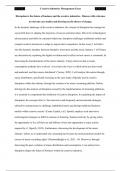Creative Industries Management Essay
Disruption is the future of business and the creative industries. Discuss with reference
to relevant case studies and drawing on the theory of change.
In the dynamic landscape of the creative industries, the concept of disruption has emerged as
a powerful force in shaping the trajectory of success and innovation. Driven by technological
advancements and shifts in consumer behaviour, disruption challenges traditional models and
compels creative businesses to adapt to surpass their competitors. In this essay, I will delve
into the dynamic interplay between disruptive innovation and the music industry. I will frame
my discussion by exploring the digital revolution and its effect on how music is consumed. In
discussing the transformation of the music industry, Vaizey observes that as music
consumption methods have evolved, ‘so too have the ways in which artists are discovered
and marketed, and their music distributed’ (Vaizey, 2022). I will analyse this notion through
music distributors, specifically focusing on the case study of Spotify and its creative
disruption within the industry through the creation of its music streaming platform. Before
delving into the analysis of disruption caused by the implementation of streaming platforms,
it is essential to comprehend the definition of creative disruption. In explaining the impact of
disruption, the concept refers to ‘the innovative and frequently unconventional strategies
utilised by entrepreneurs to challenge established norms and disrupt traditional business
models within creative sectors’ (Faster Capital, n.d.). Spotify employs such innovative
technological strategies to fulfil its mission of fostering ‘human creativity by giving artists
the opportunity to live off their art and billions of fans the opportunity to enjoy and be
inspired by it’ (Spotify, 2023). Furthermore, discussing the development of the music
industry ‘allows us to understand why streaming has become the most prominent market for
owners of music recording rights’ (Hesmondhalgh et al., 2021: 14). Moreover, through
discussing the past evolution of music distribution and consumption, I can analyse how
disruption shapes the future of business within the creative industries.
, Creative Industries Management Essay
My discussion on music consumption and Spotify can be framed through drawing from
the theory of change model. In explaining the basis of the theory of change, The Centre for
Social Action Fund clarifies how the model serves as a framework that shapes how a program
influences its beneficiaries, outlining various actions undertaken for the recipients, the
ultimate impact sought, and the distinct outcomes that play a role in achieving or contributing
to that impact (Nesta, n.d.). Music distributors must align with this framework to influence
both artists, and the ease of music consumption for its listeners. It is through their
implementation of this framework that they can make a meaningful impact on listeners.
Founded in Sweden in 2006 by Daniel Ek and Martin Lorentzon, Spotify launched in 2008
and has evolved to become a global industry leader within the creative industries. However,
before its launch, the music industry was contending with the difficulties presented by the
digital revolution, such as unauthorised downloads. The advent of the MP3 audio file in the
early 1990s facilitated the convenient online distribution of music, leading to the rise of
piracy. In the UK, the creative industries mapping document in 1998 highlights how, within
the music sector, one has to consider the issue of piracy impacting the sales of exported
goods, further stating how ‘the pirate market is worth billions of pounds worldwide’
(Department for Digital, Culture, Media & Sport, 1998: 72). Digital files producing great
volumes of piracy and undermining legitimate sales was a global economic concern for the
music industry. In the wake of a piracy epidemic, Spotify provided a solution by offering a
service that bettered pirated music while still compensating the creative industry. Lee
Marshall observes how this disruption and change in the industry has been Spotify’s key
selling point by ‘offering a platform which monetises existing consumer behaviour’
(Marshall, 2015:184). He continues to express how Spotify ‘monetises an audience the large
majority of whom were downloading illegally (and therefore not making any money for the




